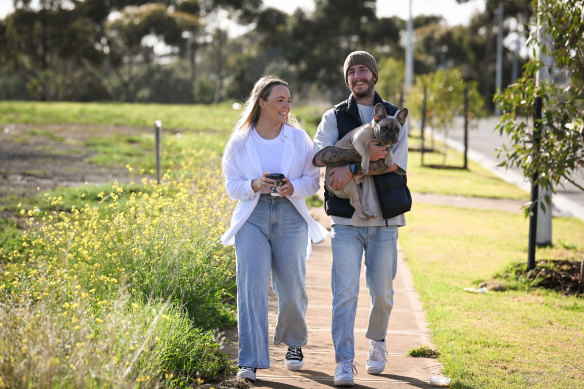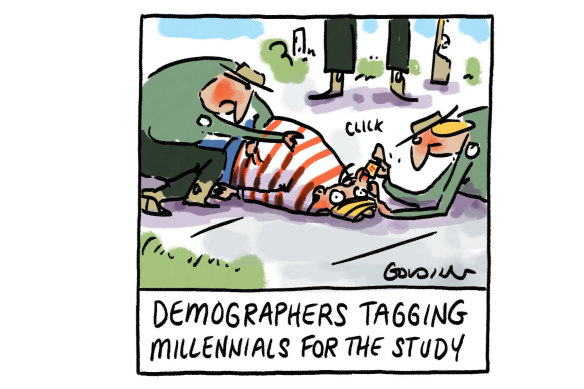This was published 2 years ago
The Melbourne suburbs where Millennials dominate Boomers and Gen X
By Sophie Aubrey and Craig Butt
Millennials are now the dominant generation in the majority of Melbourne’s suburbs, although Baby Boomers continue to have a stronghold on many of the city’s poshest locales.
Huge chunks of the inner city, the north and west are now home to more Millennials (also known as Generation Y) than any other generation, while those from Generation X are the largest age group in two pockets on either side of the bay.
Boomers are the dominant generation in the well-heeled suburbs of Toorak, Glen Iris, Kew and Ivanhoe, as well as large swathes of Melbourne’s east from Templestowe to the Yarra Valley.
The shifting generational face of Melbourne’s suburbs in the past decade is shown using census data, illustrated suburb-by-suburb in the interactive map below, produced by The Age.
Australian National University demographer Dr Liz Allen said the map showed there had been a “changing of the guard” in Melbourne’s inner-city suburbs.
Suburbs once dominated by Generation X – who were born between 1966 and 1980 and still at their peak working age in 2011 – have been eclipsed by Generation Y.
The Generations (age at time of last census in 2021)
Generation Z: age 10-24 (born 1996-2010)
Generation Y/Millennials: age 25-39 (born 1981-1995)
Generation X: age 40-54 (born 1966-1980)
Baby Boomers: age 55-74 (born 1946-1965)
By 2021, Millennials (born between 1981 and 1996) were the most common generation throughout most of the inner suburbs and along the key transport corridors heading north, west and south-east.
Major fringe growth suburbs – such as Werribee, Bacchus Marsh, Sunbury, Whittlesea, Cranbourne, Frankston and Pakenham – were also handed over to Millennials in 2021 after being Boomer-dominated in 2011 and 2016.
“These areas target first home-buying couples and young families,” said Matthew Deacon of Demographic Solutions.
Young couple Mason Frenkel, 26, and Emily Thorpe, 25, have just moved into their first home, a four-bedroom house in the new Grange Werribee development. They both grew up in neighbouring suburbs and have watched younger people move into the area, which they put down to Werribee having more affordable properties with easy access to the CBD.

Emily Thorpe and Mason Frenkel, with dog Frankie, are among the young people moving to Werribee.Credit: Eddie Jim
“There’s been heaps of new restaurants, cafes and more of a nightlife,” Thorpe said. “Everyone who lives around us is our age.”
Deacon said Generation Y’s sprawling domination could, in large part, be attributed to the city’s increase in overseas migrants, who tended to be university students and young workers.
While Boomers, born between 1946 and 1965, were the dominant cohort in 187 of the 354 populated suburbs that make up Greater Melbourne in 2011, this number fell to 104 in 2021. Meanwhile, the number of suburbs ruled by Millennials grew from 52 to 199.
Last year’s census marked the first time that Australia’s population of Millennials matched the Boomer cohort, each accounting for 21.5 per cent of the national population.
“While Baby Boomers are succumbing to mortality, the younger ages are being massively supplemented by our migration program,” Deacon said.
Many of the suburbs that Boomers remained entrenched in last year reflected “old money and wealth”, Allen said, including Toorak, Brighton, Kew, Ivanhoe, Eltham, Sandringham and Warrandyte.
“It’s almost like they’re impenetrable citadels because they are so expensive and have very little property turnover, so any incoming generation is really unable to get a foothold there,” Allen said.
She said that, while Boomers were no longer as dominant in numbers, they remained a force in terms of their political and economic wealth.
Which Melbourne suburb has the highest proportion of each generation?
Generation Z: Parkville, 39.8 per cent
Generation Y: Southbank, 55.8 per cent
Generation X: Taylors Hill, 25.9 per cent
Baby Boomers: Flinders, 40.2 per cent
Areas popular for empty-nesters and retirees, such as the Mornington Peninsula and the Dandenong Ranges, were also dominated by Boomers.
“They are ‘sleepier’ than most parts of Melbourne, so they are less likely to attract young people who want to go out to bars, pubs and restaurants.”
In 2021, Generation X’s suburbs were scattered across Melbourne in suburbs that Deacon said were significantly developed in the 2000s and attracted more mature people hoping to upsize in the past 10 years. Such suburbs included Altona, Newport, Bentleigh, Mordialloc, Blackburn and Doreen.
Generation Z (born between 1997 and 2012) only reigned in 14 suburbs last year, many being areas near universities such as Parkville, Clayton and Bundoora.
But their time will come in the next 10 years, Deacon said.
“As overseas migration recovers, this generation will be boosted significantly, as the Gen Ys were from 2011 to 2021,” he said.
Allen said the generational labels were, of course, invented terms (Boomers for example span about 20 years, compared to 15 years for other generations) but provided a helpful means of understanding Melbourne’s changing face over time.

Credit: Matt Golding
The Morning Edition newsletter is our guide to the day’s most important and interesting stories, analysis and insights. Sign up here.